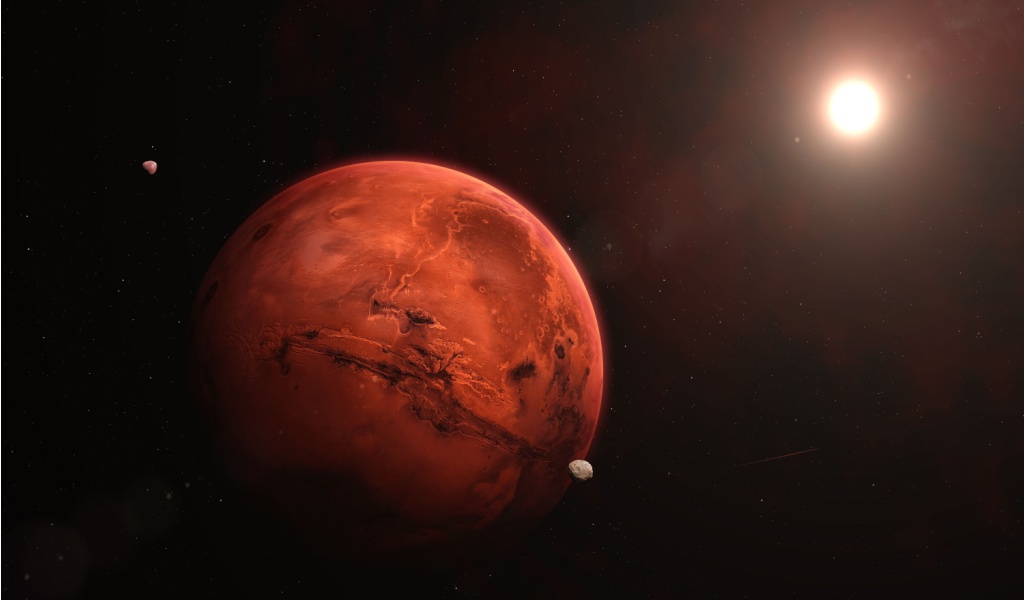Mars, the fourth planet from the sun and our neighbor, has been the focus of many space missions and continues to be one of the most intriguing celestial bodies in the universe. Regarded to be the planet most similar to Earth with the potential for supporting life, NASA has been involved in numerous missions to investigate more about this dusty, cold desert world. Plus, it is the only planet where rovers have been sent to roam its alien landscape.
Like Earth, Mars has seasons, extinct volcanoes, polar ice caps, and canyons. The Romans named Mars after their God of war because of its reddish color, which resembles blood. The Egyptians called it Her Desher, meaning “the red one.” Many still refer to Mars as the Red Planet because the iron minerals in the dirt oxidize or rust, leading to its reddish surface.
Mars continues to reveal new and intriguing secrets, and if you’re interested in learning more, keep reading!

Mars Was Once A Vacation-styled Beach Planet
According to findings made by China’s Zhurong rover during its journey across Mars, the planet was once a prime holiday spot replete with sandy beaches along the shoreline of a huge ocean called Deuteronilus over 3 billion years ago.
Just like the seas you find here on Earth, it is believed that this ancient ocean would once have harbored life. Since this rover landed on Mars in 2021, it has been trundling along the dried-up shoreline and scanning for any geological signs of evaporated ice and water. Thanks to the ground-penetrating radar that can scan beneath the planet’s surface, it was discovered that layered structures with formations called foreshore deposits existed. This suggests that there were once rivers flowing, land being built and eroded, and sediment moving. These findings offer a snapshot of what the landscape on Mars would once have looked like!
Mars May Have Once Been A Blue Planet
A recent study suggests that we could be wrong about how Mars got its reddish color. While this was attributed to rusted iron minerals dispersed billions of years by winds, this may not be the reason. Previous spacecraft observations led scientists to deduce that this rust came about in dry conditions after the water on the planet had disappeared.
However, newer findings proffer the contrary. They indicate that the red hue comes from reactions in wet conditions, suggesting a possibility of life on the planet. Recent research believes that Mars’ red hue is matched by ferrihydrite, an iron oxide that contains water. So, the planet’s reddish color must have formed way back when Mars was a cool ocean world. Simply put, Mars could be red today because it was blue in the past!
Tons Of Water Frost Discovered At The Top Of Mars’ Volcanoes
Scientists were excited to spot water frost at the top of Mars’ tallest equatorial volcanoes for the first time. This discovery defies any previous belief that the presence of water on Mars is impossible.
This theory was brought about by a hair-thin dusting of frost at the peak of volcanoes in the Tharsis region of Mars—the largest mountain in the entire solar system with up to three times the height of Mount Everest. During colder months, the frost could make up about 150,000 tons of water—equivalent to 60 Olympic swimming pools!
According to the discovery, frost condenses along the summits of the mountains every night and evaporates under the sun’s heat. The European Space Agency’s Orbiter first spotted the frost as it captured high-resolution color images in the morning hours. By carefully analyzing the 30,000 images, researchers concluded that frost forms in the unique microclimates from the cool air reaching the peaks. It’s possible that these images could be remnants of an old climate cycle on modern Mars, where there could have been precipitation or even snowfall on these volcanoes a long time ago.

The Speed Of Sound On Mars Is Always Changing
New analysis suggests that the speed of sound on Mars changes by temperature and location, making it very different from what we are accustomed to here on Earth. NASA’s Perseverance Rover has many microphones which are intended to study the properties of materials on the planet. These devices have picked up on many additional sounds, including a bizarre spluttering of Martian dust devils. Recordings confirm that sound behaves very strangely on Mars. For example, any noise below 240 hertz travels about 30 feet per second slower than high-pitched sounds. This discrepancy could be due to the carbon dioxide molecules (which make up 95% of Mars’ atmosphere) absorbing some of the sound’s energy at lower frequencies.
On Earth, sound travels at a single speed, but the velocity of sound is not a universal constant. It can vary depending on the temperature and density of the medium it travels through. So, the denser the medium, the faster it travels. Since Mars’ atmosphere is more tenuous than Earth’s, sound would propagate differently on the red planet.
NASA’s Rover Makes Breathable Oxygen On Mars
In a groundbreaking experiment, NASA’s Perseverence Rover has generated enough oxygen to keep an astronaut alive on Mars for three hours. This rover, which first touched down on Mars in early 2021, generated oxygen using its MOXIE (Mars Oxygen In-Situ Resource Utilization Experiment) device, which converted carbon dioxide in periodic bursts over two years.
Since the rover arrived on Mars, it has generated 4.3 ounces, or 122 grams, of oxygen. This oxygen is equivalent to what a small dog would breathe in 10 hours. This development has given scientists hope that human life could one day be sustained on this planet, which was once believed to be inhospitable!
While this is a significant step forward, many health challenges remain. Mars is so cold that it could freeze a human to death without a space suit. Its low atmospheric pressure would also boil their blood. To top this, cancer-causing radiation from the lack of a protective ozone layer is a significant concern, along with extreme loss of bone density.



